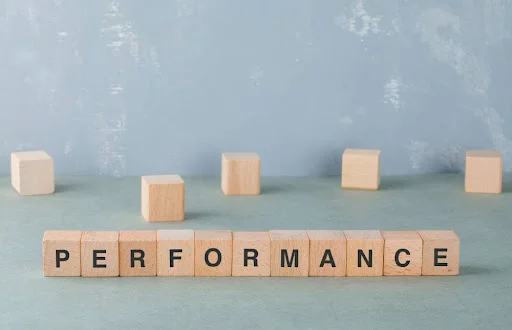Criteria for effective performance assessment
Performance appraisal is an important and effective tool for all organisations, but its effectiveness depends on how it is carried out. Its primary aim is to create a workplace climate where employees can do their jobs in a supportive environment, enjoy their work, be recognised for their performance and turn their weaknesses into strengths. At the same time, if performance appraisals are aimless and not well thought through, they can become a situation of accountability, exams and even dismissals.
In this article we will now review how:
- What is benchmarking?
- What types are there?
- What performance assessment methods are there?
- What are the common mistakes that can occur during a performance review?
- What are the most typical questions asked during a performance appraisal?
- What software can help you benchmark?

What is benchmarking?
Performance appraisal is a method of measuring an employee's work and results based on the employee's job duties.
It is a great opportunity for the manager and the employee to give each other feedback on a specific period, the achievement of goals, any difficulties and discuss how they can work as effectively as possible in the future. It is also very important to discuss how the employee feels about his/her working environment, his/her role in the organisation, his/her motivation and career opportunities.
What is the purpose of a corporate performance appraisal system?
Performance appraisals are an important feedback to organisations on what support systems, training or possible changes are needed to help employees work most effectively.
In addition, the performance appraisal system aims to:
- Provide regular feedback to employees to make them more aware of their strengths and effectiveness against performance indicators.
- If there are any gaps, encouraging the employee's development in the area.
- Increasing the motivation of subordinates.
- Improving communication, competence and efficiency.
- Providing objective criteria for important decisions, such as salary increases, promotions or dismissals.
- Improve the functioning of the team or organisation, thereby increasing customer satisfaction.
- Positioning employees within the organisation.
- Identifying career goals.
Who should do the evaluation?
In any case, it should be assessed by the person who knows the employee best, has the best insight into his or her tasks, behaviour and achievements. In most cases this will be the immediate supervisor, but sometimes it may be an external partner or even a colleague.
How often and in what form should performance reviews be held?
Opinions are divided on this. Some people monitor annually, others every six months or even every quarter. Many organisations prefer a written form, while others believe that a verbal assessment is also excellent. The design of a performance appraisal system should always be tailored to the needs of the organisation, there are no hard and fast guidelines.

Types of performance assessment
Performance appraisal can be carried out at individual or team level, but it is often not only the performance of employees but also that of managers that is under scrutiny in each method. Let's look at them now.
Employee self-assessment
The method first involves a performance appraisal questionnaire, which is mostly scored and text-based. The employee grades his/her performance, strengths and weaknesses when completing it. The same is done by the manager with the subordinate - so that points of agreement or disagreement are clearly visible. Completing the test is followed by a discussion aimed at motivating and improving efficiency.
360 degree assessment
It is a comprehensive assessment method, as the name suggests: that is, the person is assessed from all sides - 360 degrees.
Following the self-assessment, the employee is reviewed not only by his/her supervisor, but also by colleagues at the same level as the employee and, if there are any, by his/her subordinates. Customers or suppliers who have daily contact with the employee may also be interviewed. The tests are anonymous, so that those interviewed can be completely honest about their opinion of the person and their activities.
The assessment is made in writing or orally on the basis of the evaluation form. The person being assessed describes him/herself on the same questionnaire as the one filled in by colleagues.
It is a very effective method, but also very time-consuming.
Managerial assessment
In this survey, employees can rate the effectiveness of their direct or indirect manager at work. The answers help them to better understand their managers' performance, their attitude at work and how supportive they are of their subordinates.
Senior management assessment
The method is designed to get employees' perspectives on senior managers, to assess their skills and to ensure that the results support managers in running the organisation smoothly. This questionnaire should include questions that help to gain insights into effectiveness, leadership, rule-making skills, among others.
Employee satisfaction measurement
The survey plays an important role in finding out how satisfied or dissatisfied employees are. This is important because dissatisfaction not only results in employees not performing as well, but can also be a trigger for high turnover. In many cases, if an employee does not feel challenged enough in their job or lacks recognition, they will become dissatisfied with their daily tasks. Performance appraisals can shed light on the causes and then find solutions.
Team evaluation
Team assessment surveys provide insight into what management thinks about individual and team performance.
Training and development needs assessment
It is essential that employees feel that there are different training opportunities available within the organisation. It is very motivating if the company also supports the development of competences related to the current job or possibly offers retraining for another job. Mapping needs in this direction will also help to design or fine-tune training and development programmes.
Performance assessment methods
Performance appraisal can be based on a variety of methods, let's look at some of the best practices.
Grading, rating scale
This is one of the best-known assessment methods, of which there are several variants. Performance criteria are defined and graded on a scale of 1-5, for example. The advantage of this method is that the evaluation process is quick, cost-effective and easy to compare.
Informal assessment, essay
The essay is primarily used for development purposes, as it provides a more comprehensive picture of the employee being assessed. The disadvantage of this method is that it does not provide the opportunity to compare employees.
Critical cases method
The evaluator identifies the subordinate's outstanding good and bad cases, tasks and projects, but this is only used to complement other methods.
Standard rules of work
This method focuses exclusively on products and the factors used to produce them (labour time, number of items, etc.).
Checklist scale
In the case of the checklist, the employee is characterised on the basis of yes/no answers.
Goal-oriented leadership
This technique sets future targets against performance and is formulated jointly by the appraisee and the appraiser.
While in the previous cases only one person is assessed, there are also methods that allow for the simultaneous assessment of several persons.
Ranking
It's about ranking employees in order from best to worst.
Jack Welch's method of constraint allocation
In this method, employees are divided into different performance groups in the ratio 20-70-10%. The aim is also to identify the best and worst performers.
- 20% - this is for employees who are key players, pulling the strings in the team
- 70% - they're the ones that perform well
- 10% - these are the worst performing workers
This method has been sharply criticised by many for not necessarily providing an objective picture of performance and thus a basis for making a decision, as there may be a period in a person's life when an otherwise high performer is performing worse.

What are the common mistakes that can occur in performance appraisals?
While the primary purpose of performance appraisal is to increase efficiency and motivation, there may be mistakes that prevent it from having the desired effect. What are they?
No specific targets
Problem: For many organisations, there is no real performance evaluation system, but it is a necessary evil in the life of the company that has to be done. This is why it is inefficient, because it is not based on pre-established objectives, and employees perceive the process as an exam, a questioning.
Solution: The effectiveness of employees can clearly be increased by supporting and motivating them, so it is very important to conduct the evaluation according to their interests and needs. Talk about training, career path, strengths, how to improve weaknesses, what are the short and long term goals.
No recognition, no motivation
Problem: The employee has achieved a nice increase in his/her work, but only receives a simple verbal congratulation.
Solution: It is very important to motivate your staff, otherwise they will lose their effectiveness. It is a good idea to discuss future plans and goals so that they can see exactly where they are going and keep the momentum going.
Wage increase negotiation
Problem: Although performance appraisals can lead to a pay rise, this is not the purpose of the process, so it is not worth going into the details of this in the discussion.
Solution: The main focus should be on the work done, the competences and the areas to be developed, and additional objectives. Salaries should not be forgotten, of course, but that is something that should be addressed in a subsequent step.
Performance appraisal sample: the most typical questions in a performance appraisal
There is no general pattern for performance appraisal, as it varies from company to company, from profile to profile, and from individual to group level.
However, there are some popular and effective questions that are often asked in surveys.
Let's look at some examples!
Questions about qualifications, job title
- How do you plan to improve yourself?
- Do you know exactly what your job entails?
- Do you know exactly what is expected of you?
- If you are given a task, can your manager trust you to do it?
- If you get an extra task, can you do it?
- Are you good at focusing on your work?
- In a complex task, can you see through it?
- Are you open to new IT solutions?
- Can you work in a team?
- Can you represent your own interests?
- Are you able to represent the interests of the organisation?
Questions on job satisfaction
- What motivates you to do your job well?
- What are your favourite tasks?
- What are the tasks you don't enjoy at all and why?
- What are 3 things we could do better as an organisation/team?
- On a scale of 0-10, how likely are you to recommend us to your friends and acquaintances?
Attitude issues
- Can your behaviour be a model for others?
- Do you keep your commitments?
- What you say can be trusted?
- Do you speak respectfully to your colleagues?
- Are you patient in conflict situations?
- If a problem arises, do you report it immediately?
- If there is a problem, do you criticise?
- Can you focus on the solution to the problem?
- Are you tolerant with your colleagues?
- Do you help your colleagues when they are in need?
- Can you decide for yourself if there is a problem?
- Do you participate in joint activities outside working hours?
Questions on effective leadership
- Do you feel that the management of the organisation treats everyone fairly?
- What leadership qualities do you have?
- Give an example of a time when you used leadership qualities in this organisation?
- Do you think there is effective communication between employees and management?
Questions on value added
- What have you done to improve the overall success of the organisation?
- What is your idea of recognition?
- Do you get regular feedback from your colleagues, your manager?
- Do you feel valued in this organisation?
Questions on workplace culture
- Have you proposed any effective changes to office policies or procedures?
- How often do you communicate with your manager and colleagues?
- Do you help your peers with the information they need to complete their tasks successfully?
- Have you ever had an unpleasant argument with a colleague, manager or supervisor?
- How do you think you could make a positive change in workplace culture?
Software help for benchmarking
Today, there are software solutions that support benchmarking processes, saving a lot of time and effort.
Employment Hero
Employment Hero excels at creating custom rating scales. You can easily identify areas where employees are performing well and areas where they need improvement. In addition, you can check that employees' performance indicators are in line with the company's goals.
Engagedly
This software helps managers and employees to work together to achieve common goals in a safe environment where they both need to trust each other. It provides the necessary tools to monitor progress towards key corporate indicators, while engaging, motivating and rewarding employees at all levels of the organisation.
Factorial
Factorial is very good software because it can be tailored to the company's own system. It is suitable for implementing an automatic evaluation system. Results can be stored in one place and access to the results can be given to managers and executives. The company's performance management can also be tracked.
Summary
Performance appraisals, when done well, increase employee motivation, engagement and performance, and provide an opportunity to improve any weaknesses. To do this, we always need to know what the exact purpose of the appraisal is and focus on the needs of the employees. They should never feel unappreciated and held to account.
Although for some employers it is just an unnecessary administrative burden, if we become really good at it, it can be an excellent tool to increase the efficiency of the organisation and reduce turnover.

 Designabc
Designabc